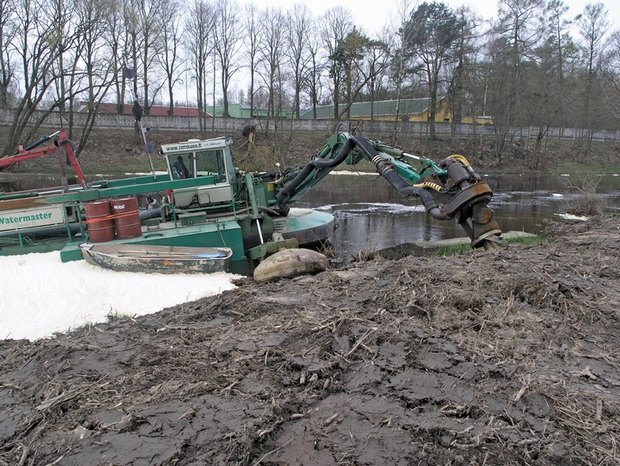
Cleaning up the polluted river sediments of the Nevezis river in Panevezys. Photo: Richard Langlais
As with the other countries of the Baltic Sea region, Lithuania is also particularly vulnerable to the impacts of climate change. Notwithstanding this however, research data on the local impacts of climate change in Lithuania remains at a premium.
According to Lithuania's third and forth national communication on climate change to the United Nations Framework Convention on Climate Change (UNFCC) published in 2005, the country will face similar impacts as its neighbours: average temperatures will rise in winter while snow cover will be shorter than was previously the case.
The amount of precipitation will also rise thus increasing the risk of flooding. Agriculture and forestry will likely be the most affected sectors. Climate change is also expected to lead to a number of significant health challenges as well as precipitating biodiversity loss.
The municipalities of Lithuania vary significantly in their approach to, and activity in respect of, climate change related issues. In October 2008 12 Lithuanian municipalities signed the Covenant of EU Mayors, launched by the European Commission in January 2008, designed to go beyond the greenhouse gas emission objectives set by the EU for 2020.
According to Audrone Alijosiute, Director of ECAT Lithuania, a non-governmental organization that helps municipalities in implementing environmental regulations, around 15 to 20% of Lithuanian municipalities are currently active in respect of climate change issues. More important than the size of the municipality or the impacts that the municipality is likely to face due to climate change, however, are the individuals in municipalities and their interest in climate change issues.
One of these key individuals is Ms Zita Tverkute, head of the environmental department in Panevezys city municipality, the fifth largest city in Lithuania with 116200 inhabitants. Located in the north central part of Lithuania, Panevezys lies on the banks of the river Nevezis which runs through the city. The river Nevezis floods frequently, but worse than the damage caused by flooding is that caused to the private well system by polluted river sediments. Inhabitants are still largely dependent on private wells rather than public water pipes and drainage systems.
The Nevezis' riverbed is highly polluted by chemicals such as mercury, lead and cadmium used by the Soviet-era factory that used to stand on its banks. The city has now, however, finally begun to address this issue by cleaning the river and removing the polluted sediments. About 1.2 km of riverbed has been cleaned so far and the city has technical plans ready for cleaning another 12 km of riverbed. To be able to do this the city is applying for money from the European Union's Structural Funds.
Even though the Environmental Department of the municipality of Panevezys consists of only three people, Ms Tverkute has been very successful in her operations. Panevezys is known across Lithuania for its extensive cycle paths which run throughout the entire city. The city started to construct these paths in 1995 and now has a network of some120km. The most vulnerable land area in the middle of the city adjacent to the actual course of the river Nevezis is dedicated to a beautiful park area criss-crossed by cycle paths and pathways.
Engaging politicians in environmental and climate change action however remains a significant challenge in Lithuania, where so many other societal issues remain to be addressed. It is a common refrain across Lithuanian to hear that it is impossible to work with issues of climate change which today seem so far in the future, when there are so many roads to fix and new infrastructures to build. In addition it is clear that climate change issues remain under-resourced at all levels of government. In the Ministry of Environment there are only three people working with all issues related to climate change policy – national and international.
Public awareness of the basic issues in respect of climate change is perhaps the largest challenge for Lithuania in this area. Sergej Suzdalev from BEF Lithuania, an environmental NGO, thinks that the media should have a larger role to play in changing people's understanding of climate change. Currently the only thing that the Lithuanian media is doing is scaring people and making climate change look like a big global problem which individual countries, or people, cannot easily impact.
Another misperception that is quite common is that climate change will not have that significant an effect on the country. This may be due to the fact that little research has actually been done on the local impacts of climate change in Lithuania, a point significantly highlighted in Lithuania's third and fourth national communication on climate change for the UNFCCC (2005).
